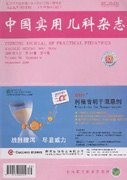|
Analysis of characteristics and predictors of Mycoplasma pneumoniae necrotizing pneumonia
ZHUO Yu-fei*,LIU Jin-rong,LI Hui-min,et al
2020, 35(12):
973-976.
DOI: 10.19538/j.ek2020120612
Objective To summarize the clinical manifestations,imaging characteristics and bronchoscopic changes in Mycoplasma pneumoniae necrotic pneumonia. Methods All the patients included in the study were hospitalized from January 2013 to August 2017 in our department. Leukocytes count,neutrophils count,C-reactive protein,imaging characteristics and bronchoscopic changes in 22 Mycoplasma pneumoniae necrotizing pneumonia patients were retrospectively analysed and compared with 16 necrotic bacterial pneumonia patients. Results The neutrophil count and CRP value ??of Mycoplasma pneumoniae necrotizing pneumonia patients within the first 3 days after the onset of fever were(74.62±5.78)% and (58.0±25.8) mg/L respectively,which were significantly lower than those of necrotic bacterial pneumonia[neutrophil count at (88.0±3.15)% and CRP at (164.5±96.6) mg/L],with P<0.001. In both groups,neutrophil account and CRP value were significantly elevated in the 4th to 7th day after the onset of fever[neutrophil count at (83.6±6.91)% and (87.68±2.89)%,CRP at (142.3±57.2) mg/L and (155.0±39.5) mg/L respectively],and no significant difference was found between them with P>0.05. The white cell account in children with Mycoplasma pneumoniae necrotizing pneumonia didn’t increase within the first 7 days of disease onset. In Mycoplasma pneumoniae necrotizing pneumonia,consolidation of a whole lobe (or nearly a whole lobe) appeared on the 4th to 11th day after disease onset,while in necrotic bacterial pneumonia it appeared within the first 5 days. The necrosis of lung tissue occurred after 2 weeks of disease onset in Mycoplasma pneumoniae necrotizing pneumonia and within 10 days in necrotic bacterial pneumonia. Mucus plug obstruction and mucosal necrosis were found under bronchoscopy in necrotic mycoplasma pneumonia,and more than half of them developed bronchial obstruction,which was not found in bacterial pneumonia. Conclusion Characteristics of Mycoplasma pneumoniae necrotizing pneumonia include increase of neutrophil count,increase of CRP and consolidation of whole lobe in the 4th to 7th day of disease onset,while there is no increase of white cell count;there is little lung tissue necrosis within 2 weeks of disease onset;there exists mucosal necrosis under bronchoscopy,and later bronchial obstruction is likely to occur.
|

